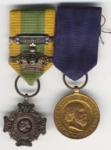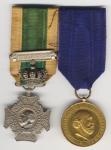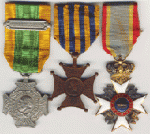
ErikMuller
Past Contributor-
Posts
316 -
Joined
-
Last visited
Content Type
Profiles
Forums
Blogs
Gallery
Events
Store
Everything posted by ErikMuller
-
Polish - Order of Polonia Restitutia
ErikMuller replied to a topic in Central & Eastern European States
1944 was the date dat the Polish Peoples Republic was founded. Its communist regime reinstituted the award as being an award of their own. -
Portugal - Ordem do Infante Dom Henrique
ErikMuller replied to beertje's topic in Southern European & Balkan States
Funny thing is that there also was a Dutch prince which was called Henry the Navigator. He was Prince William Frederick HENRY, born at Soestdijk on 13 June, 1820 and died at Walferdange, Luxembourg, on 13 January, 1879. He enlisted in the Royal Netherlands Navy on 13 June, 1830 (only 10 years old) and was promoted the only Admiral of the Fleet the Dutch navy ever had, on 7 January, 1879, only five days before his death. Appearantly that was why the Dutch Navy was present with 3 ships (an aircraft carrier, a frigate and a submarine) at the commemoration. Strangely the submarine captain (Lieutenant-Commander Juta) only received the medal, where his 'larger' companions received both the medal and the order. -
Portugal - Ordem do Infante Dom Henrique
ErikMuller replied to beertje's topic in Southern European & Balkan States
Appearantly there was a fleet review (sorry if my English translation is wrong, in Dutch its a "vlootschouw") to commemorate the 500th anniversary of the death of Henry the Navigator in September, 1960. A lot of non-portugese naval vessels took part in it. Among it were Dutch and German vessels. I have found a couple of Dutch naval officers which received the medal and a couple of Dutch captains which received either a grand officer or a commander in the order (and the medal). -
Belgium Belgian order of Leopold ll
ErikMuller replied to Laurence Strong's topic in Northern European & Baltic States
Thanks! I'm trying to update as much as I can, but time is a dangerously limited factor. And I still have to write English pages to, to make it accessible to non-Dutch visitors. -
Belgium Belgian order of Leopold ll
ErikMuller replied to Laurence Strong's topic in Northern European & Baltic States
A shame, would have loved to dig into that! A former-member of the Dutch Orders and Medals Research Society (SRO) is currently writing a list of Dutchmen who received Belgian awards and I'm still looking for picture material to assist him. Yes the site is mine, being inspired by Hendrik's website a couple of years ago! -
Belgium Belgian order of Leopold ll
ErikMuller replied to Laurence Strong's topic in Northern European & Baltic States
Nice! Won't happen to have a name with this major do you? Cheers, Erik http://www.onderscheidingen.nl/nl -
Netherlands The Dutch Expedition Cross
ErikMuller replied to ErikMuller's topic in Northern European & Baltic States
I will leave it at this for the moment, maybe later I will add some pictures of recipients and award documents... now time for a nice cold beer -
Netherlands The Dutch Expedition Cross
ErikMuller replied to ErikMuller's topic in Northern European & Baltic States
-
Netherlands The Dutch Expedition Cross
ErikMuller replied to ErikMuller's topic in Northern European & Baltic States
Pair: - Expedition Cross with clasp 'Atjeh 1873-1874' and Crown for the Honourable Mention - Atchin Medal 1873-1874 -
Netherlands The Dutch Expedition Cross
ErikMuller replied to ErikMuller's topic in Northern European & Baltic States
Miniatures of the beforementioned Captain W.F. de Kock van Leeuwen - Lombok Cross 1894 - Expedition Cross with clasp 'Atjeh 1873-96' -
Netherlands The Dutch Expedition Cross
ErikMuller replied to ErikMuller's topic in Northern European & Baltic States
Group of three, attributed to Captain W.F. de Kock van Leeuwen, secretary/keeper of records - Expedition Cross with clasp 'Atjeh 1873-1896' - Lombok Cross - Knight of the Order of the Wendish Crown of Mecklenburg-Schwerin -
Netherlands The Dutch Expedition Cross
ErikMuller replied to ErikMuller's topic in Northern European & Baltic States
Group of three: - Expedition Cross with clasps 'Zuid-Celebes 1905-1908' and 'Atjeh 1896-1900' - Lombok Cross 1894 - Officers' Long Service Cross -
Netherlands The Dutch Expedition Cross
ErikMuller posted a topic in Northern European & Baltic States
On request of Rick Research: Ereteken voor Belangrijke Krijgsbedrijven By Royal Decree no. 123 of 31 May, 1833 Prince William of Orange (later to be King William II) proposed the institution of a General Service Decoration. However, it took 36 years before this award was actually created. By Royal Decree no. 13 of 19 February, 1869 the Cross for Important Military Operations was instituted. It was to be awarded to those who had participated in major military operations (the so-called expeditions; because of this the cross is also known as the Expedition Cross) and to those that had committed an act of gallantry while in military service. The cross should always have at least one clasp attached to the ribbon. An exception to this rule is when the cross was awarded for gallantry, in which case there should be a Crown for the Honourable Mention or two crossed swords (for the Sword of Honour) attached to the ribbon. It is, however, unlikely that the recipient of such gallantry awards didn't receive clasps to his Cross. It is a four-armed silver-coloured cross, 39 mm in diameter. The obverse has a portret King William III in a round badge, surrounded by a garter with the legend "VOOR KRIJGSVERRIGTINGEN" (for military operations) and a wreath of oak leaves. On all four the arms is a stylised "W" (for William). The reverse is plain. The ribbon is light green with yellowish orange borders. Silver clasps (42x9 mm) are worn over the ribbon. At institution 6 clasps were approved for military operations dating back to 1846. In the years afterwards 27 other clasps came to being. The last one for Timor in 1942, making it a total of 33 clasps: "Bali 1846" "Bali 1848" "Bali 1849" "Borneo 1850-1854" "Boni 1859" "Borneo 1859-1863" "Guinea 1869-1870" "Deli 1872" "Atjeh 1873-1874" "Atjeh 1873-1876" "Samalangan 1877" "Atjeh 1873-1880" "Atjeh 1873-1885" "Atjeh 1873-1890" "Tamiang 1893" "Atjeh 1873-1896" "Atjeh 1896-1900" "Korintji 1903" "Djambi 1901-1904" "Gaj? en Alaslanden 1904" "Atjeh 1901-1905" "Midden-Sumatra 1903-1907" "Zuid-Celebes 1905-1908" "Flores 1907-1908" "Kleine Soenda-eilanden 1905-1909" "Atjeh 1906-1910" "Nieuw-Guinea 1907-1915" "Atjeh 1911-1914" "W.Afd. Borneo 1912-1914" "N. Guinea 1907-1915" "Ceram 1915" "W-Kust Atjeh 1925-1927" "Timor 1942" -
Belgium Belgian Soldier Medals Group
ErikMuller replied to Igor Ostapenko's topic in Northern European & Baltic States
Big trucks, small trucks? How many metres? Looks like fun to make an inventory for Making an inventory always is a terrible job. In this case I think that it just doesn't have any priority. It is remarkeble that Jan has access to this lot of paper yet. In the Netherlands it would be unheard of that someone gains access to an uninventorised archive! Even for me as an keeper of records it is inpossible! @vatjan I smell an SKF-article here Jan! -
Netherlands The Dutch WW2 Commemorative Cross
ErikMuller replied to Hendrik's topic in Northern European & Baltic States
Dear Rick, The Prussian mounting style is in use since 1913. It protects the medals from rubbing against each other and also prevents from sticking all kinds of medals on a military uniform (you are only allowed to wear one row only, with a maximum of 16 medals). The 'old style' hanging from the ribbon is only used for civil uniforms and miniatures nowadays. Medals are by the way never mounted individually, but always as a group. The only two medals which don't have a suspension ring are the War Commemorative Cross and the Decoration for Order and Peace and because they are sewn onto the ribbon, they are actually the only two medals which don't get lost easily. Suspension rings have a nasty habbit of breaking! -
Netherlands Netherlands : Badge for the Wounded
ErikMuller replied to Hendrik's topic in Northern European & Baltic States
The large badge is worn on the military uniform on the left breast beneath the service ribbons, in the same way as proficiency badges. The miniature is for civil clothing and is worn on the lapel of a jacket. Cheers, Erik -
Netherlands The Dutch Flying Cross
ErikMuller replied to Hendrik's topic in Northern European & Baltic States
The 'Dutch strike' has a blank reverse yes, but it also has a small makers mark (a staff of Mercury) on the left rim. Appearantly the two crosses, which were awarded in 2002 to a Dutch and an American Air Force pilot were of the old Gaunt type, which were cleaned and lacquered to keep them clean in the future. -
Netherlands The Dutch WW2 Commemorative Cross
ErikMuller replied to Hendrik's topic in Northern European & Baltic States
Hi Hendrik, The NOORD AFRIKA - ITALI? 1941-1942 bar was never actually made. The first crosses were awarded mid 1948 and recipients of the 1944 "temporary award" only received their temporary brevet and a ribbon bar (the dark orange with dark green side edges I gave you a while back). Cheers, Erik PS I tried to upload some pictures of different award documents for the OHK, but although the smallest was only 80 Kb I get: The total filespace required to upload all the attached files is greater than your per post or global limit. Please reduce the number of attachments or the size of the attachments. What's wrong?





